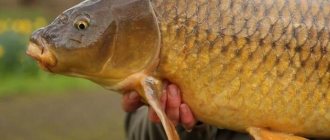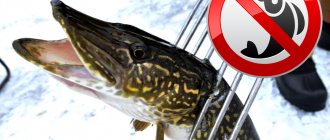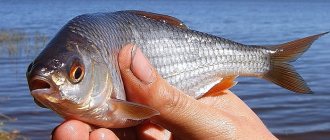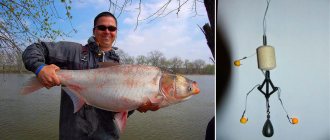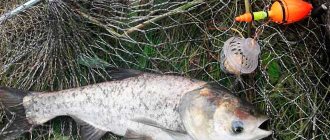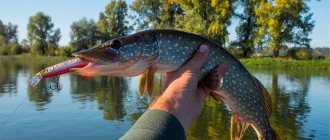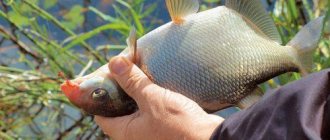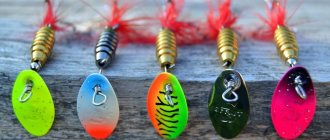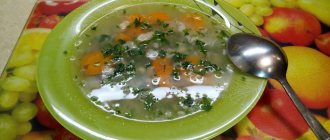Fishing for silver carp in the fall is often much more productive than fishing at any other time of the year. By this time, the silver carp accumulates a fairly decent amount of fat, which only adds to its taste. In addition, he continues to actively feed, which naturally contributes to a good bite.
General information
Gradually, silver carp fishing is becoming more and more popular. Many strive to catch this strong and dexterous inhabitant of reservoirs.
For commercial purposes, fishing with nets is especially common. Silver carp can also be caught with a seine, but experienced fishermen believe that this cannot be compared with fighting with silver carp one on one. Moreover, silver carp, as this fish is also called, is the only freshwater carp that contains the same fat as its marine counterparts.
Fishing in autumn
Fishing for silver carp in the fall has its own characteristics. Cloudy and cool weather does not please this heat-loving fish at all. In addition, by the beginning of October, all vegetation in the reservoir almost completely disappears. Therefore, silver carp often have to go closer and closer to the bottom to get food, moving further and further from the shore. And when the water temperature drops to eight degrees, it stops feeding altogether, swimming to wintering pits.
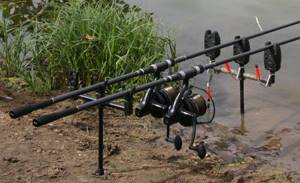
The best weather conditions for successful silver carp fishing in the fall are considered to be the absence of wind and light drizzle. At this time, you can find the location of large fish by watching a school of roach, which also swims to shallow water in the hope of finding the last plant food.
Where to catch silver carp in the fall
In rivers, silver carp prefers to stay in places with slow currents and a muddy or clayey bottom at a depth of over three meters. Less often - on stones and pebbles. On warm and clear days, it swims to shallow waters where remnants of vegetation are still preserved, which can be detected by roach or rudd, which gather in small schools in such areas.
On lakes and ponds you can count on a silver carp bite in the following places:
- where there is at least some kind of hill or hillock at the bottom;
- in the groove;
- on the edge or slope.
In addition, silver carp likes to hide among snags and flooded trees.
Features of autumn fishing
Catching silver carp in September or October requires camouflage and silence. Suspiciousness is a characteristic feature of silver carp. If he suspects something is wrong, he will immediately swim to the depths or for cover. Hearing any extraneous sounds, the silver carp begins to get nervous and make “acrobatic” jumps, jumping out of the water and plopping back down with a huge noise. At this time, he is not at all interested in bait.
The best time to catch the coveted prey is to catch silver carp in the fall, especially in the last two months of this time of year, when the already large fish is already accumulating substantial reserves for wintering.
Their feeding habits allow the silver carp to filter the water, taking out any leftover food from it. Therefore, the likelihood that he will swallow the hook is very high. However, catching silver carp in the fall requires certain knowledge from the fisherman.
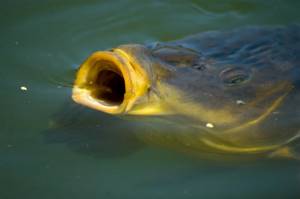
Silver carp fishing in spring
When the water has not yet warmed up to 18 degrees, silver carp feeds on ditritus and lives at the bottom of the reservoir. At the end of spring, the water warms up to 20 degrees and the silver carp bite becomes more active.
The silver carp gives a noticeable rebuff, so be prepared for this so as not to “dive” after it. The silver carp resists and pulls down, but anyone can pull the fish out, the main thing is not to weaken the line.
Bait when catching silver carp
The diet of silver carp includes phytoplankton: algae, larvae, water grass. When fishing for silver carp, bait is maggots, bloodworms, clover or nettle leaves, wheat bran, and flour. The main thing in catching silver carp is creating a “cloud”.
September silver carp
Catching this representative of cyprinids in the first autumn month is almost unpredictable. Therefore, experienced fishermen prefer to combine it with hunting for other fish. To do this, use a bait, feeder or carp stick with good load-carrying capacity.
Since catching silver carp in September may involve long casts, the main element in the equipment should be a loaded feeder weighing from forty to seventy grams. The fishing line should have a diameter of 0.25 mm.
At this time, peas cooked until completely boiled - the consistency of a puree - are ideal as complementary food for silver carp. To secure the peas in the feeder, they need to be strengthened with breadcrumbs. The bait can be a foam ball with a diameter of up to eight centimeters. In this case, when casting, the tackle must descend to a clean bottom.
The optimal time for catching silver carp in September is the period when the school is “walking” near the surface. As a rule, these are the morning hours, when the fish bask in the rays of the rising sun near the shallows. Having made a cast to the found place, you don’t have to wait long for a bite. Often, after half an hour, the alarm - a regular bell or its electronic version - goes off.
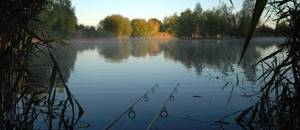
Blitz tips
- Silver carp is a shy fish. During fishing, complete silence and camouflage must be observed.
- The fishing line is chosen to be at least 0.25 mm.
- When fishing, it’s a good idea to have a hook with you. You have to be very careful when pulling out the fish, because it offers quite strong resistance.
- It often happens that the current interferes with successful fishing. The bait is carried away from the place where it was thrown. To avoid this, put on a sliding weight weighing about 100 grams. depending on the capabilities of the rod. When the weather is calm, you can remove the sliding weight from the rig, replacing it with a regular one. In this case, a large float is installed that can withstand up to 50 degrees. loads.
- Successful fishing is carried out the same way both with a donk and a float. The advantage of the latter is the possibility of fishing at different depths. Also, when floating, it is important to use two baits - heavy and light. The first creates cloudiness in the water, the second is used as an additional one.
September fishing technique
In early autumn, during the day, silver carp often stay in open water. At this time, it can easily be found in areas with weak currents or on sandbanks, especially near thickets of aquatic vegetation and riffles. Sometimes he swims up to the very shore before sunset, adhering to the depth and boundaries of the shallows.
The secrets of catching silver carp in the first autumn month are to hold the fish while fishing, since it is distinguished by powerful strength and desperate resistance, and can suddenly jump out of the water to a height of up to one and a half meters. The struggle of silver carp is extraordinary and differs from the behavior of other inhabitants of water bodies. No matter how tired he is, you should not pick him up with your bare hands, as sudden and strong twitches can injure the angler. And in order to get it, it is better to use a hook.
Description and behavior characteristics
Silver carp is a valuable commercial fish. It is found in schools mainly in fresh waters, preferring to feed on phytoplankton and algae. It is difficult to confuse an aquatic inhabitant with other inhabitants due to some features in appearance and behavioral habits.
In silver carp:
- silver body;
- big head;
- high forehead;
- small eyes located slightly below the mouth.

The ponds of China are considered the homeland of silver carp; it used to be called “Chinese silver carp.”
By species, hybrid, bigheaded and silver carp are distinguished:
- Whites prefer to live in muddy greenish water, constantly cleaning it of detritus and feeding on phytoplankton.
- Variegated individuals feed on zooplankton and river vegetation. They live up to 20 years, reaching 1 meter in length.
- Hybrid, bred by breeders, are considered the most common type of commercial fish. They are distinguished by the presence of a large head covering almost half of their body and feed on zooplankton. They go to spawn late (closer to July), when the water temperature is no lower than +20°C. Hybrid silver carp are voracious and are considered caretakers of overgrown reservoirs, because in short periods of time they can destroy all algae, thereby improving lakes and reservoirs. Average weight is 4-5 kg upon reaching 4 years of age.
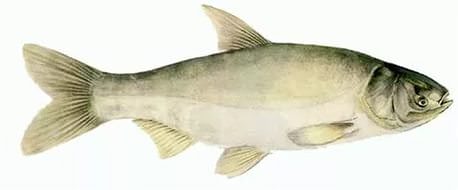
White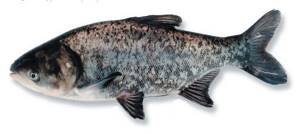
Motley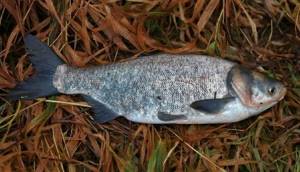
Hybrid
Fish are rarely seen on the surface of the water. When the temperature drops below +8°C, it goes into the depths of the water and the bite stops. Although you can often see splashes on the water when the fish jumps out of the water, making loud sounds.
In winter, silver carp goes into sleep, preferring deep holes in the reservoir. Thanks to reclamation features, heat-loving silver carp have now acclimatized to our Russian conditions. They are found in the waters of different regions of the country, growing up to 2 meters in length and weighing up to 0.5 centners, eating all kinds of algae in large quantities.
In some places in Russia the climate is quite harsh and fish are not capable of reproduction. This is of particular interest to experienced fishermen. Catching a large specimen is a success, although one weighing 3-4 kg can be caught quite well.
Choosing a fishing spot
When choosing a place for fishing, you need to know: if there is a lot of natural food in the reservoir, then there is practically no chance of catching silver carp. This circumstance can be determined visually - by color: the water should not be greenish. But in reservoirs where there is a lack of food supply, you can catch more than one large specimen.
It is better to catch silver carp on relatively small rocky rivers with sharp changes in depth. A place for fishing should be chosen based on the following criteria:
- with a rocky, clay or sandy bottom;
- with a depth of no more than four meters.
Habitats
China is considered to be the birthplace of this commercial fish, then it was spotted in the waters of the Amur. In 1960, it was brought from China to the former USSR. It was bred in artificial reservoirs or in fenced areas of rivers. Subsequently, a wider distribution of fish occurred.
Prefers rivers, lakes and reservoirs with warm temperatures, without strong currents. On the shallows, whole flocks bask in the warm morning sun. They love creeks and bays with warm water, staying in medium, non-cold depths.
Very often, silver carp live in canals and reservoirs near power plants, where warm water is released. They inhabit lakes and rivers with dense vegetation, which are heavily overgrown with grass, with a muddy bottom. Feels great in ponds with standing water.
What to fish with
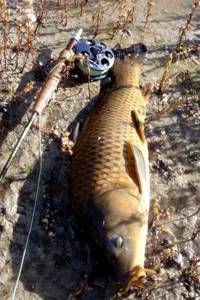
Until recently, it was believed that any equipment for catching silver carp could be chosen. But it is not so. There are certain requirements for it. But the most important thing is that it must be characterized by increased strength, since we are talking about catching fish with very strong resistance, capable of making fairly powerful throws. That is why the equipment for catching silver carp must be reliable, not torn or broken after the first fishing.
For this purpose, you can use a feeder, a hook, as well as any carp “sticks”, preferably having a good load-carrying capacity. Large specimens are quite shy and very rarely swim closer to the shore than eight or ten meters. Therefore, catching silver carp with a fishing rod is very rare, because the latter must have an impressive length and the ability to cast as accurately as possible, which is not typical for this tackle. However, often when fishing for carp, he himself falls for it.
Silver carp fishing
Catching silver carp is difficult and interesting, both with a long-cast fishing rod and with a feeder (donka).
Silver carp (English name - silver carp) belongs to schooling fish of the carp family. Reaches a weight of 50 kg and a length of 1 meter. The average weight of silver carp is 25-30 kg. The size of the catch depends on the fishing location and time of year.
Silver carp meat is juicy, fatty and tender. The meat is made into cutlets, the heads are boiled into fish soup, the canned food is also sealed, baked in the oven and simply fried. The species is widespread in Europe and Central Asia.
Silver carp spawning
Silver carp become sexually mature at 5-7 years, and spawn during the summer flood. The female spawns 490–540 thousand pelagic eggs. Spawning occurs when the water temperature reaches 18-20 °C in May-June. The caviar is floating. Spawns on the current in places with whirlpools. The eggs are pelagic and swell and grow in size and develop in water.
Silver carp food supply
Juveniles feed on zooplankton, while adults switch to phytoplankton or mixed feeding. Silver carp feeds on microscopic algae - phytoplankton, so this fish is an excellent ameliorator of reservoirs. Bighead carp has a varied diet, which in addition to phytoplankton and detritus contains zooplankton (a source of protein).
In large bodies of water, silver carp live not far from the sandy shore, where the current is minimal. They are also introduced into small ponds, as this breed tends to live next to soft vegetation with a muddy bottom. When the sun sets, schools of silver carp swim to the shore, but when the first rays of the sun appear, they retreat to a safe distance. In mid-September, the water temperature begins to drop, and the silver carp “goes to winter.”
Bottom tackle
Experienced fishermen most often use spinning rods with a reel, although some use float gear at shallow depths. However, silver carp often feed in the bottom layer, where they calmly eat plankton. Therefore, catching silver carp with bottom tackle is especially important. Moreover, as the water gets colder, when plant food begins to gradually die off, this type of fishing becomes the only catchable one.
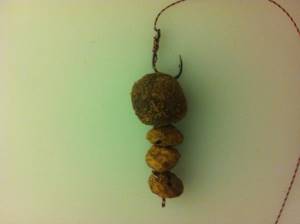
At the same time, catching silver carp using bottom tackle takes into account the special characteristics of the structure of the mouth of this large inhabitant of reservoirs. It does not have the ability to collect food directly at the bottom, so the hooks must be placed at some elevation from the underwater ground, at a distance of at least ten centimeters.
Many people use such tackle as a “silver carp stick”. The principle of its operation takes into account not only the structural features of the silver carp’s mouth, but also the nuances of its nutrition. Technoplankton developed specifically for catching this fish is used as bait, bait and bait. This product looks like a barrel with bait compressed inside, along the axis of which there is a hole for attaching it to a “silver carp stick.”
Silver carp bite by season
Spring
The lack of food in the reservoir forces the silver carp to lean on detritus, occasionally floating to the surface of the water surface. Spend most of your time at the bottom. The nozzle should be placed at a distance of 5-10 cm from the bottom.
Before spawning, which is May - early June, a strong bite begins. The fish grabs the hook and does not pay any attention to what is baited on it. Anglers prefer foam balls and foam rubber. They have no odor that can scare away fish.
If islands of vegetation appear, which the wind blows into one place, the silver carp feeds there. By throwing the tackle with bait 15-25 cm from this place, you can confidently expect a successful bite.
Summer
There is practically no bite.
There is an abundance of live and plant food; it does not respond to artificial baits. The hotter the weather, the more diverse the food supply becomes. But this does not mean that silver carp will not bite. Early in the morning, in places where the water is clear and not muddy, you can seduce him with your favorite bait. He greedily destroys it and cannot be tempted to do anything else. And when the water becomes cloudy and overgrown with duckweed and grass, there will be no bite.
Favorite places in summer are sun-warmed shallows with rich vegetation. Spinning rod and float rod are the main gear at this time. It is cast shallowly, about 2-3 m from the surface of the water. In cloudy weather, silver carp hides in driftwood and snags. The gear is cast deeper.
Autumn
The heat-loving silver carp does not like cloudy and cold weather. It descends closer to the bottom to find food and moves further and further from the shore. And at +8 it doesn’t bite at all, stops looking for food and descends into holes at the bottom of the reservoir for wintering.
If you catch it in the fall, then only in warm, windless weather, preferably with light rain. By this season, it fattenes up by filtering the water, collects the rest of the food, and at the same time swallows bait. Tries to stay in shallow water, where the water is a little warmer.
Autumn fishing requires maximum caution and silence. With an unexpected noise, the fish begins to jump out of the water; it has no time to eat. A suspicious silver carp goes deeper or takes cover.
Convenient fishing tackle: float rod, donka, feeder. It bites on porridge and techplankton.
Winter
It is not common for silver carp to go into suspended animation. At times it goes out in search of food, but when there is ice cover it stays in deep holes. It feeds on small crustaceans and bottom detritus, which is quite enough for it.
During thaws, when the ice melts, successful fishing is guaranteed. In the absence of food, it is easy to interest him in feeding other fish. It bites well on technoplankton and is sold in fishing stores. The gear is thrown almost to the bottom.
A jig with bloodworms and other plant baits is suitable for fishing. They mainly use a donk, a zherlitsa, and a feeder. Winter silver carp is a powerful and large fish. For this reason, gear must be strong and durable. He will resist fiercely and strongly, but the tired resistance fades away. Now all that remains is to bring it to the hole and pull it out with a small hook.
A silver carp weighing 102 kg was caught in 2008 in the Kharkov region, Ukraine.
Float
To catch this fish, a transparent type of float is used, since ordinary ones can frighten silver carp. In this case, the descent must be selected taking into account the fact that this fish feeds deep from the surface.
If reeds or various sticks are floating on the water surface in a pond, then you can use a balsa float to catch silver carp. At the same time, this equipment should not be positioned vertically, since the fish are alarmed and frightened when all the reeds or small twigs float horizontally on the surface of the reservoir, while the position of the foreign bite alarm is different. The float must be mounted so that it is in the same plane.
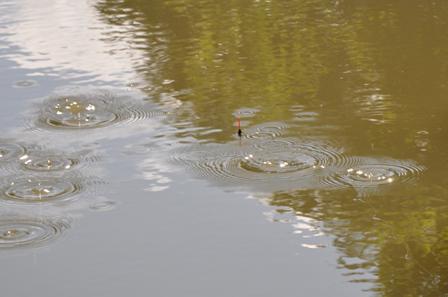
Most often, when fishing for silver carp, two types of this component of equipment are used. The first is a spindle-shaped elongated foam float surrounded by several pellets. Its upper part is painted in some color noticeable from a considerable distance, and the lower part, located in the water, is always painted in a protective shade. The second option is ordinary floats that have a not very noticeable antenna. The line in them is passed through the cambric. They are loaded in such a way that they lie on the surface of the water of the reservoir.
Tackle for bigheaded fish
Upon closer examination, the tackle for silver carp does not contain any special tricks. It consists of several structural elements: a sinker on an anti-twist tube, a massive foam float and a diamond-shaped structure on which a barrel of compressed bait - technoplankton - is placed. Let's look at each element in more detail.
First of all, an anti-twist tube is put on the main line, to which a sinker is attached using a fastener. The shape of the load and its color are completely unimportant, because... it lies at the bottom, and all the rest of the equipment is in the subsurface layer of water. The main purpose of the sinker is to anchor the equipment, since it should not drift during fishing. The weight of the sinker is selected in accordance with the fishing conditions.
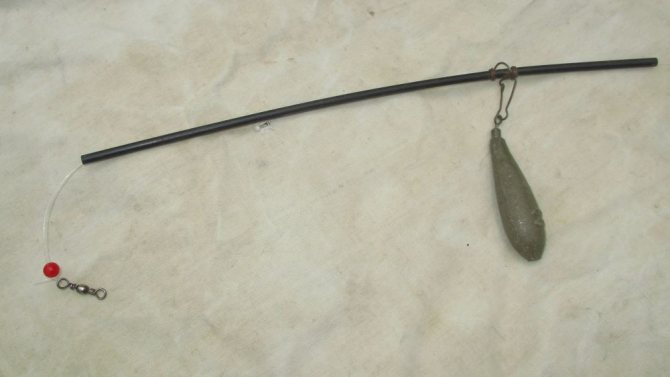
It is also important how exactly the equipment for silver carp is delivered to the fishing point. After all, it can not only be thrown from the shore, but also brought in by boat. In the first case, the sinker must be selected so as to provide the required casting distance, but not overload the tackle. We use weights weighing 80 g - quite enough.
So, we put an anti-twist tube on the main fishing line, then we put a bead that will protect the knot from damage, and we knit a large swivel to the fishing line. A rig with all the other items listed above will be tied to the other end of this swivel.
Ready-made equipment for silver carp can be purchased at almost any fishing store. In our region, the price for it ranges from 100 to 200 rubles. Some of the factory equipment is quite suitable for fishing without significant modifications. And for those who want to try bighead fishing for the first time, we would advise buying one piece of equipment in the store, but only so as not to read long descriptions, but to see with your own eyes how everything works there. And, having disassembled this equipment into its component elements, tie it again, but with your own hands.
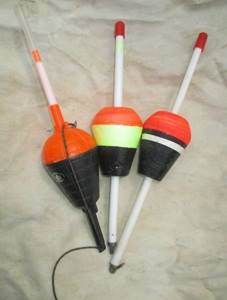
Firstly, it’s more reliable, and secondly, it’s remembered once and for all. My wife and I prefer to knit our own rigs from store-bought items. But we are confident that not a single element of the equipment will fail at the most crucial moment.
Let's start with the float. It is a massive body made of hard foam, through which a thick-walled plastic tube is passed, which simultaneously serves as an antenna and a keel. On sale you can find floats with a plastic body that is integral with the keel and antenna.
But we prefer those models in which the foam body is not fixed dead on the tube, but moves along it with force. Then, depending on the fishing conditions, you can either lengthen the antenna (for better visibility when casting long distances in calm weather), or increase the underwater part, making the float more stable on high waves. And if desired and the necessary materials are available, floats for silver carp can be made even while fishing from improvised means.
I especially want to emphasize that the foam from which the body of the float is made must be hard, and the tube must be thick-walled and durable, since the float experiences heavy loads when hooked.
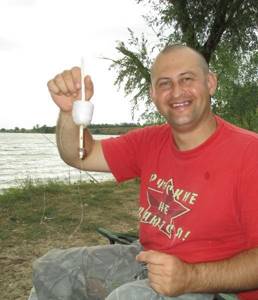
On some floats, the line is passed through the central hole of the foam body and pressed with a keel tube, but we consider this design to be unsuccessful, because Over time, the fishing line saws through the foam body (by the way, this is exactly how floats are designed in inexpensive ready-made equipment). A much more successful design solution is when at the bottom of the plastic tube there is a fastening loop for passing the fishing line, so that the float is sliding.
In this case, its movement along the main line can be easily limited by two rubber stoppers. And it is better if the fastening loop is not made of plastic, but of lead. Firstly, it is more reliable, and secondly, the lead loop already surrounds the float, so that in the water it is in a slightly inclined state.
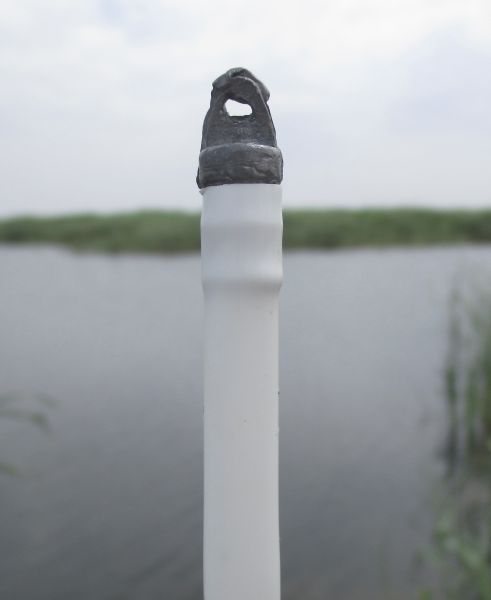
We did not set out to measure the carrying capacity of the float for catching silver carp, but I think it holds 60-70 grams afloat. This is enough for a wire diamond equipped with a barrel of technoplankton.
The next structural element is a steel wire bent in a special way, forming a rhombus. Those diamonds that we came across for sale were made from ordinary bicycle spokes. Therefore, you can make them yourself. However, I have tested it myself: bicycle spokes bend very hard, and it is almost impossible to give them the desired shape without heating.
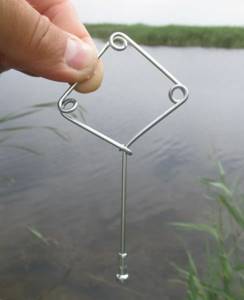
It’s better to buy a ready-made diamond in a store, especially since it doesn’t cost much more than a bicycle spoke, which still needs to be bent. And somehow we pulled out of the water a factory-made silver carp rig with a plastic float that had been torn off by someone. Instead of a diamond, there was a T-shaped structure that performed the same functions as a diamond.
The diamond has three holes: the top one for tying to equipment, two side ones for short leashes with hooks. A barrel of technoplankton is placed on the central axis. On some ready-made equipment, a 20-gram sinker with a through hole is also placed on the central axis. But if we use floats that are already loaded at the bottom with a lead loop to pass the fishing line, then the sinker turns out to be superfluous.
Let me explain: a whole barrel of technoplankton weighs up to 50 g, and in the water the already loaded float becomes strictly vertical under its weight. However, as the technoplankton dissolves, the float begins to gradually tilt - and this is a signal to the fisherman that it is time to replace the dissolved barrel with a fresh one.
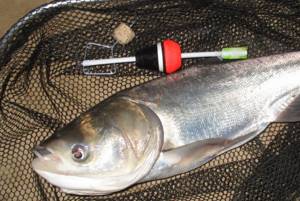
So, on a piece of fishing line with a diameter of 0.3 - 0.4 mm and a length of 70 - 100 cm, we put on a float, stop rubber bands that limit its movement up and down, and tie a wire diamond to the lower end of the fishing line. The upper end of the rig is tied to the main fishing line, which, as we remember, already contains an anti-twist tube with a sinker and a swivel. All that remains is to tie the leashes to the side holes of the wire diamond - and the equipment is ready.
We make leashes from braided fishing line with a diameter of 0.14 - 0.16 mm. We tie the hooks so that one of them is located approximately in the middle of the technoplankton barrel, and the second is at the level of its lower edge or even slightly lower. The length of the leashes in this case turns out to be 5 - 8 cm. The hooks are carp, with a short shank and a round bend, and it is definitely not worth going small with their size: for an average silver carp weighing up to 5 kg, it is better to take hooks No. 3 - 4, for more massive fish may need larger ones.
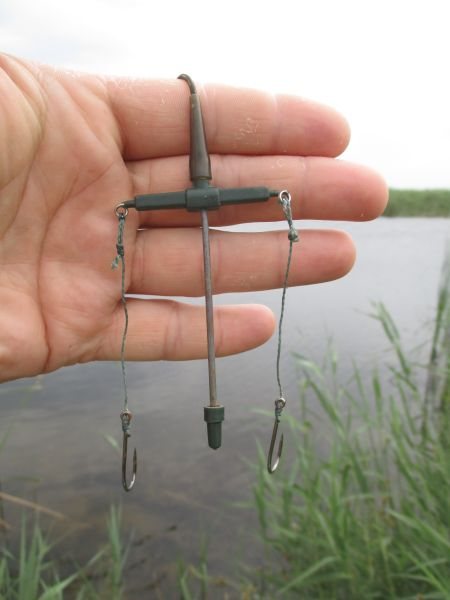
Our powerful feeders with a length of 3.6 - 3.9 m and a dough weight of up to 150 - 180 g, which we use on the Volga, are ideally suited for casting equipment for silver carp. Carp rods and even very budget fiberglass rods are also suitable. Frequent recasts are not required for such fishing, and a safety margin when fighting silver carp is never superfluous.
Fishing on top
In this case, you need to feed the bait to the silver carp in such a way that it floats directly on the water surface. To do this, use a water-filling ball or floats with an oval body made of foam, plastic or balsa wood, through the central axis of which a plastic hollow tube passes. The fishing line should be inconspicuous with a diameter of 0.25-0.3 millimeters and a length of up to one and a half meters.
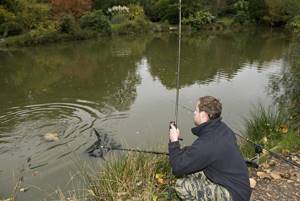
Sometimes pieces of cucumbers and cabbage, peas (canned or boiled), seaweed, soft parts of mushrooms, melon, berries, etc. are used as bait. Silver carp can grab the bait very quickly, but if the hook is not sharp enough, it will spit it out just as quickly and sails away. Often, when choosing a bait, experienced fishermen take into account the fauna of the reservoir in which silver carp are caught.
How to choose bait depending on the season
The activity of fish always depends on the time of year. Therefore, the baits chosen for each pore are different.
In winter, you should catch silver carp when there is a thaw or after the first ice appears. Hooks are available in 4 sizes. The best baits for them are bloodworms and jigs. You can use scented baits and corn. Before fishing, you should feed the fish for at least two days. A small hole is made in the ice and plant bait is poured into it. Choose a fairly strong fishing rod with a thick fishing line. When fishing, the bait should be at the very bottom.
When spring comes, silver carp feeds on detritus (the top layer of silt). Unlike in winter, the nozzle is placed 10 cm from the bottom. The ideal bait at this time is polystyrene foam or small pieces of foam rubber. They have no smell, so they are not able to scare away fish.
The best time to hunt silver carp is summer. At this time there is a lot of natural organic food and he practically does not pay attention to artificial baits. The best time of day to catch him is morning. In summer, he chooses places where there is a lot of vegetation for his parking. You can use insects, cereals, technoplankton, pieces of vegetables and mushrooms as bait.
In autumn, its activity decreases significantly. Silver carp can be found at this time in those sections of rivers where the current is weak, especially in shallow water. There he looks for the remains of vegetation. It is good to catch bait from porridge and technoplankton tablets. For fishing, use a float rod, donka and feeder.
Lure
In reservoirs where there is a lot of food, it is quite difficult to seduce this fish with something original. Bait for silver carp is absolutely necessary, but the quantity should be within reason. A fish can ignore one bait today, and a few days later only catch it. Many fans of this type of hunting know that silver carp is quite original in its choice of complementary foods, although maggots or bloodworms must be a mandatory element in it.
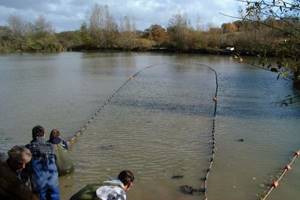
Anglers sometimes use grass bait such as nettle or clover leaves. But most often a crust of bread or canned corn is used as bait. For this purpose, it is better to use a soft French bun. After placing the bread on the hook, you need to pierce the crust twice on both sides. Then unfold it in such a way as to pierce the top with a sting again. This way the crust will stay on the hook better and not fall off when casting. At the same time, its size should not be too small, because while the fish that should be hooked swims up to it, it can be eaten by such small things as roach, rudd, perch or crucian carp.

